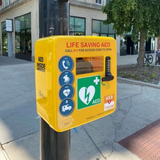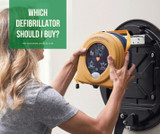Guidelines for CPR and how AED’s can assist us
CPR undoubtedly increases a patients survival rate when they have suffered a sudden cardiac arrest (SCA). Knowing how to deliver it correctly however can be daunting with questions surrounding how fast and deep to pump the chest often scaring people into not wanting deliver CPR.
According to studies, nearly 30% of people wouldn’t perform CPR if they saw someone fall ill, ultimately putting lives at risk. Less than one in ten people survive a SCA out of hospital due to low CPR bystander rates, compared to this figure being one in four in countries where such training is more common.
When someone suffers a SCA they need CPR and defibrillation immediately. Defibrillation helps by monitoring the hearts rhythm and delivering a shock if one is needed in order to restore it back to it’s natural pace, without one, a patient would likely die. In order for defibrillator to be it’s most effective however, CPR must also be delivered. Giving easy to understand prompts, defibrillators guide users through the correct CPR process in order for the best care to always be delivered.
The Powerheart G5 AED helps any user deliver high quality CPR in accordance with current guidelines whilst keeping them calm in what can often be a stressful situation. If equipped with the ICPR system, this AED can have a unique motion sensor and algorithm that can monitor the rescuers CPR compressions.
With such up to date technology guiding users through the correct CPR process, patients can receive the best care possible in order to have the best chances of survival. Voice and text prompts provide those delivering care with instructions to help them achieve the compression rate targets and with a clever combination of coaching and feedback, the best CPR performance can be achieved.
The Powerheart G5 AED delivers prompts via text and audio indicators to say ‘press, press, press’ at the required rate and if the pace needs to change will even indicate, ‘press faster’ or ‘press slower’. Keeping pace with the audio prompts or visual flashing LEDs ensures the correct CPR pace is kept throughout the entire process.
When delivering adequate CPR, the rescuer must aim to achieve chest compressions of between five and six centimeters, with prompts informing the caregiver of when they are doing this perfectly, it not only ensure the best care is given, but also gives great user confidence.
Chest recoil is also an important part of CPR which can often be overlooked. Just as important as pumping the chest at the right depth and pace, making sure the rescuer fully releases the compression is of the same importance. With the ICPR system helping with Powerheart G5 AED with this, it can give a prompt to ‘press harder and fully release’.
In adults, it is usual for those giving care to deliver CPR compressions at a rate of 100 to 120 per minute with more compresssions being associated with higher survival rates. Compressions create blood flow to the heart, in turn helping oxygen to reach the heart and brain to ultimately help save the victims life.
Overall, when delivering CPR, rescuers must remember to perform chest compressions of 100 to 120 compressions per minute, compress to a depth of at least 5cm, fully release after each compression, minimise pauses and ventilate adequately (two breaths per thirty compressions). All of this combined greatly increases the chance of survival for someone suffering a SCA.
(For the latest guidelines on resuscitation please visit the Resuscitation Council website).
Recent Posts
-
Empowering Communities: The Lifesaving Impact of CPR on Restart a Heart Day
Every year, on and around October 16th, an important event takes place - Restart a Heart Day. This a …16th Oct 2023 -
Which home defibrillator?
80% of all out of hospital cardiac arrests occur at home. Defibrillators are often available in loca …4th Dec 2022 -
Which defibrillator should I buy?
There are many defibrillators available on the market and it can become overwhelming knowing which o …4th Nov 2022




